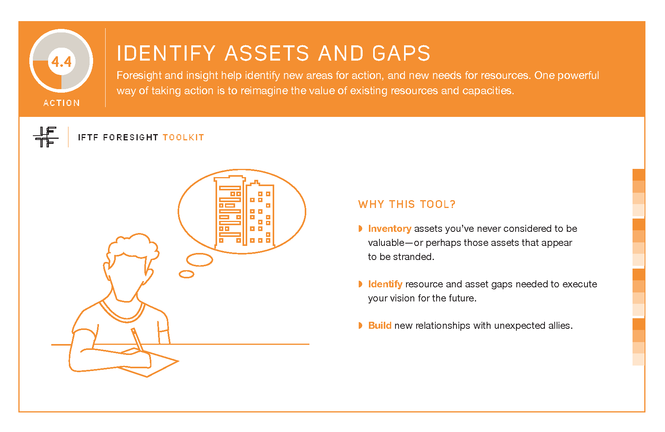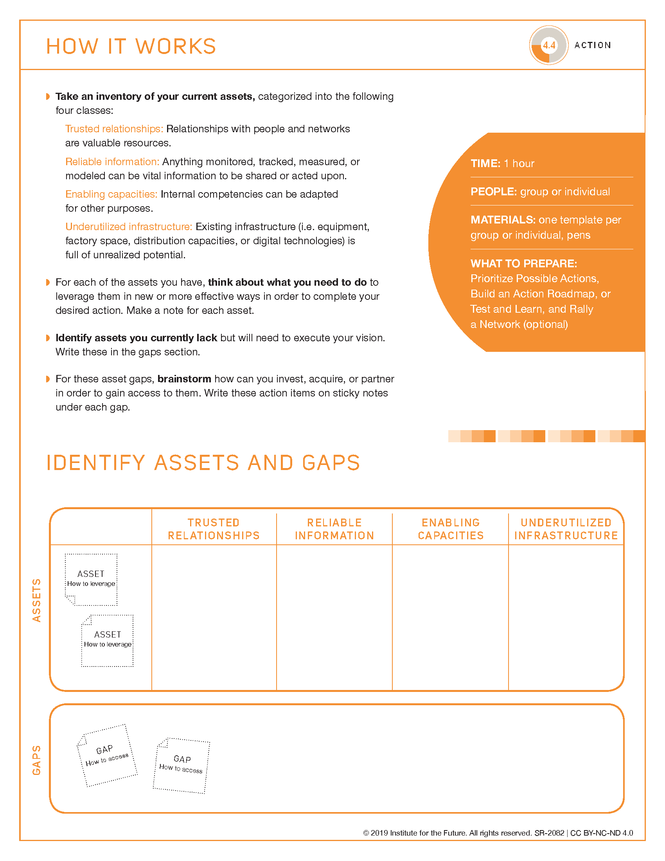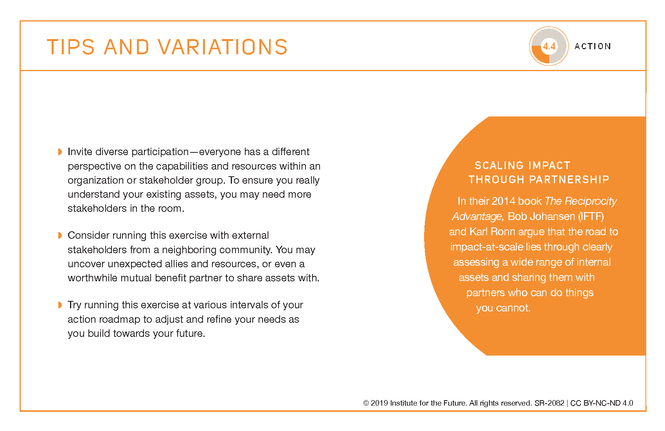Future Now
The IFTF Blog
Identify Your Assets and Gaps: A Foresight Tool for Action
The small, compact city of San Francisco was hosting a large conference. People were flying into the foggy city from all over to attend the event. Hotels were filling up with eager occupants, and the late planners were being left without a mattress and pillow to rest their heads at night. A couple of young men residing in the city, strapped for cash, saw an opportunity to earn some extra money. The two roommates had an air mattress and space to offer in their apartment, so why not provide a place for a stranded conference-goer to crash for a couple days? This is the birth story of Airbnb, a 14-year old company now worth almost 80 billion dollars.
Airbnb is a useful platform because it allows almost anyone to leverage their empty spaces for travelers who simply need a place to spend the night. We can create value for ourselves and others if we leverage the unique and idling assets we have while simultaneously filling the gaps or weak spots we find around us. One could say that the success of any endeavor like Airbnb is due to a simple calculation of minding our assets and gaps.
The Networked World of 2015: A Foresight Tool’s Origin Story
At the Institute for the Future’s 2015 annual Ten Year Forecast Summit, IFTF facilitated an exercise taken from its Toolkit for the Networked World for its attendees to help them systematically think through what assets their own organizations had lying around which were full of unrealized potential and could be leveraged or monetized for new value. Did they have unused land, parked trucks, or old media content? According to IFTF Vantage Partnership Co-Director Dylan Hendricks, one of the leading organizers of the conference, “Organizations always have underutilized assets.”
Back in 2015 BP (Before Pandemic), the economies of many industrial nations were looking fragile and fragmented. As the summit’s toolkit explained, “If the world feels chaotic right now, it’s because we’re actively deconstructing the institutions of our past in order to build the foundations for our future. Amidst the turmoil of this transition, the opportunity of the next decade is to reconnect these deconstructed pieces in new ways—not just to rebuild the world we knew, but to build a world that works for a hyperconnected global population of eight billion.” There was a lot of buzz and many signals of change around connecting assets that had never been connected before. Although Airbnb and companies had been around for several years (Airbnb was founded in 2008), these once fringe companies had begun entering the mainstream, and more businesses wanted to understand their magic. One of the interesting signals of that time was a company called Roadie, a distributed delivery service which shipped packages with drivers who were already headed in the right direction (think UPS + Lyft) and had them exchange parcels at Waffle House eateries, which already had a vast network across the U.S. and conveniently placed next to highway exits. If Roadie and Airbnb could develop a model for connecting assets and gaps, why couldn’t anyone else?
From a One-Off Exercise to a Systematic Tool
Summit attendees enjoyed the provocation and space to think of their underutilized assets so much that IFTF turned the exercise into a proprietary tool in the IFTF foresight toolkit for its public foresight trainings. Our training alumni will recognize it as Action Tool 4.4 Identify Assets and Gaps. In 2015, the tool provided a systematic method for connecting assets and ideating in previously unconsidered ways, but the concept of underutilized assets is no longer novel seven years later, and has been internalized by many. According to Hendricks, fewer companies are doing today what they were back then. The opportunity space we once saw has been gobbled up by big players like Amazon who dominate the market with their scale and resources. While the tool certainly still has value, Hendricks also points out that it’s rarely someone’s chief concern in a project to figure out how to use underutilized assets. It’s also a tool with a specific goal, which makes it harder to apply in a more general context, much like the other tools in our foresight toolkit.
So, for the first time ever, IFTF Foresight Essentials has decided to retire a tool from the Toolkit and provide it freely for all to use. The public can now download a PDF of this full tool, without having taken the IFTF Foresight Essentials training. Print your own blank copy of the template or turn it into a digital workspace (i.e. Miro or Mural) for collaborative futuring with colleagues.



Hope for a New Era: Using the Tool to Find New Social Value
As a civic futures organization, our hope at IFTF is that the public will find more ways to use the Identify Assets and Gaps tool for social impact by realizing the gaps and untapped potential of our underutilized social assets. Hendricks thinks that one of society’s most underutilized assets is its human communities. He points to our past eras when organized religion was a centerpiece of society that united communities through deep shared meanings. Now, with the rise and projected growth of the religiously unaffiliated in the United States as well as a steady drop in Americans’ trust in institutions since 1979, as social drivers, there remains an unfilled need for an uniting narrative and a legitimate public entity that people can look up to. How can we find new value in the public assets we possess? How can we leverage our human communities and people power to improve the quality of life for everyone?
In a recent IFTF Signal Swap webinar, IFTF Research Director Sara Skvirsky presented a signal of change from Japan that presents one innovative way. Elders in nursing care, many with dementia or another illness, are being hired to work shifts at stores which are understaffed. This is an example of leveraging an asset—people—who maybe have overlooked, to fill a gap—Japan’s labor shortage. Nursing care centers have seen an improvement in the physical and mental well-being of elders who are working, and staff from stores where the elders work say customers have a more enjoyable shopping experience with the elders around. So, positive social change can happen if we see that the people, even those who are older in age or who are ill, have inherent value and can benefit our society in various ways.
Another asset that I personally believe we as a society fail to leverage enough is our past. Our histories are filled with lessons for us to learn from, and concrete examples of how people acted upon their imaginations, and yet many of us ignore the value. Worse, in the US, we have right-wing activists who are disrupting a comprehensive teaching of American history by banning books and blocking curriculum which includes the truth of its racist legacy. As Dutch historian Rutger Bregman says, “The past teaches us a simple but crucial lesson: Things could be different. The way our world is organized is not the result of some axiomatic evolution.” In other words, where we are today is an outcome of the past, so our future is the outcome of what we do today. We should preserve and care for the past as a valuable asset as we plan for the future.
~~~
We’re surrounded by assets and new opportunities. The Identify Assets and Gaps Tool provides a framework to unlock your creativity and futures thinking when thinking about the assets lying dormant and unrealized in your life. We encourage you to use the tool to find the value within yourself, within your organization, or within the relationships in your community so that we can collectively become future-ready.
What do you think of the tool? Tag us on social media (@IFTF) to let us know how you used it and if you found it useful!
Want to receive free tips, tools, and advice for your foresight practice from the world's leading futures organization? Subscribe to the IFTF Foresight Essentials newsletter to get monthly updates delivered
straight to your inbox.
Ready to become a professional futurist? Learn future-ready skills by enrolling in an IFTF Foresight Essentials training based on 50+ years of time-tested and proven foresight tools and methods today. Learn more ».
You may also be interested in:
- Training: IFTF Foresight Essentials
- Training: IFTF Design Futures
- Blog: Map Complex Impacts During a Time of Uncertainty



